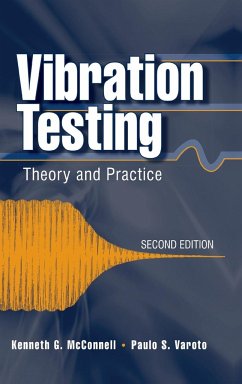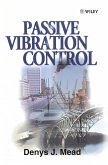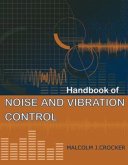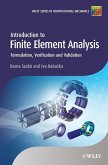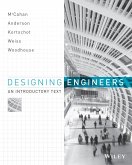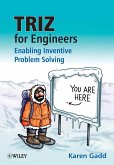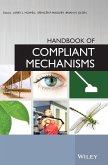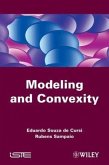- Gebundenes Buch
- Merkliste
- Auf die Merkliste
- Bewerten Bewerten
- Teilen
- Produkt teilen
- Produkterinnerung
- Produkterinnerung
Vibration Testing: Theory and Practice, Second Edition is a step-by-step guide that shows how to obtain meaningful experimental results via the proper use of modern instrumentation, vibration exciters, and signal-processing equipment, with particular emphasis on how different types of signals are processed with a frequency analyzer. Thoroughly updated, this new edition covers all basic concepts and principles underlying dynamic testing, explains how current instruments and methods operate within the dynamic environment, and describes their behavior in a number of commonly encountered field and laboratory test situations.…mehr
Andere Kunden interessierten sich auch für
![Passive Vibration Control Passive Vibration Control]() Denys J. MeadPassive Vibration Control854,99 €
Denys J. MeadPassive Vibration Control854,99 €![Handbook of Noise and Vibration Control Handbook of Noise and Vibration Control]() Malcolm J. Crocker (ed.)Handbook of Noise and Vibration Control270,99 €
Malcolm J. Crocker (ed.)Handbook of Noise and Vibration Control270,99 €![Introduction to Finite Element Analysis Introduction to Finite Element Analysis]() Barna SzabóIntroduction to Finite Element Analysis147,99 €
Barna SzabóIntroduction to Finite Element Analysis147,99 €![Designing Engineers Designing Engineers]() Susan McCahanDesigning Engineers144,99 €
Susan McCahanDesigning Engineers144,99 €![Triz for Engineers: Enabling Inventive Problem Solving Triz for Engineers: Enabling Inventive Problem Solving]() Karen GaddTriz for Engineers: Enabling Inventive Problem Solving77,99 €
Karen GaddTriz for Engineers: Enabling Inventive Problem Solving77,99 €![Handbook of Compliant Mechanisms Handbook of Compliant Mechanisms]() Handbook of Compliant Mechanisms115,99 €
Handbook of Compliant Mechanisms115,99 €![Modeling and Convexity Modeling and Convexity]() Eduardo Souza de CursiModeling and Convexity281,99 €
Eduardo Souza de CursiModeling and Convexity281,99 €-
-
-
Vibration Testing: Theory and Practice, Second Edition is a step-by-step guide that shows how to obtain meaningful experimental results via the proper use of modern instrumentation, vibration exciters, and signal-processing equipment, with particular emphasis on how different types of signals are processed with a frequency analyzer. Thoroughly updated, this new edition covers all basic concepts and principles underlying dynamic testing, explains how current instruments and methods operate within the dynamic environment, and describes their behavior in a number of commonly encountered field and laboratory test situations.
Hinweis: Dieser Artikel kann nur an eine deutsche Lieferadresse ausgeliefert werden.
Hinweis: Dieser Artikel kann nur an eine deutsche Lieferadresse ausgeliefert werden.
Produktdetails
- Produktdetails
- Verlag: Wiley & Sons
- 2. Aufl.
- Seitenzahl: 672
- Erscheinungstermin: 1. Oktober 2008
- Englisch
- Abmessung: 240mm x 161mm x 40mm
- Gewicht: 1070g
- ISBN-13: 9780471666516
- ISBN-10: 0471666513
- Artikelnr.: 25182954
- Herstellerkennzeichnung
- Libri GmbH
- Europaallee 1
- 36244 Bad Hersfeld
- 06621 890
- Verlag: Wiley & Sons
- 2. Aufl.
- Seitenzahl: 672
- Erscheinungstermin: 1. Oktober 2008
- Englisch
- Abmessung: 240mm x 161mm x 40mm
- Gewicht: 1070g
- ISBN-13: 9780471666516
- ISBN-10: 0471666513
- Artikelnr.: 25182954
- Herstellerkennzeichnung
- Libri GmbH
- Europaallee 1
- 36244 Bad Hersfeld
- 06621 890
KENNETH G. McCONNELL, PE, is Professor Emeritus, Aerospace Engineering and Engineering Mechanics, Iowa State University, and has over forty-three years' experience in vibrations and experimental mechanics. He is a Fellow of the Society of Experimental Mechanics, and recipient of SEM's M.M. Frocht Award for "outstanding achievement as an experimental mechanics educator"; SEM's highest award, the William M. Murray Lecturer, for his "outstanding contribution to SEM in the fields of dynamic instrumentation, vibration testing techniques, and fluid structure interaction"; the D.J. DeMichele Award for "promoting the scientific and educational aspects of modal analysis"; and the Brewer Award, "in recognition of his contributions as an outstanding practicing experimental stress analyst." He is the author of Instrumentation for Engineering Measurements, Second Edition (coauthored with James E. Dally and William F Riley and published by Wiley) and other books in the field. PAULO S. VAROTO is professor on Dynamics and Vibrations at the Mechanical Engineering Department, School of Engineering of São Carlos, University of São Paulo. Professor Varoto earned his BSc and MSc in mechanical engineering from the University of São Paulo and holds a PhD in engineering mechanics from the Department of Aerospace Engineering and Engineering Mechanics, Iowa State University, where he worked under the supervision of Ken McConnell.
Preface xix
1. An Overview of Vibration Testing 1
1.1 Introduction 2
1.2 Preliminary Considerations 6
1.3 General Input-Output Relationships in the Frequency Domain 8
1.4 Overview of Equipment Employed 10
1.5 Summary 12
2. Dynamic Signal Analysis 13
2.1 Introduction 14
2.2 Phasor Representation of Periodic Functions 21
2.3 Periodic Time Histories 26
2.4 Transient Signal Analysis 32
2.5 Correlation Concepts-A Statistical Point of View 38
2.6 Correlation Concepts-Periodic Time Histories 40
2.7 Correlation Concepts-Transient Time Histories 47
2.8 Correlation Concepts-Random Time Histories 50
2.9 Summary 63
2.10 General References on Signal Analysis 65
3. Vibration Concepts 67
3.1 Introduction 68
3.2 The Single DOF Model 68
3.3 Single Degree of Freedom Forced Response 76
3.4 General Input-Output Model For Linear Systems 88
3.5 The Two Degrees of Freedom Vibration Model 101
3.6 The Second-Order Continuous Vibration Model 115
3.7 Fourth-Order Continuous Vibration System-The Beam 130
3.8 Nonlinear Behavior 143
3.9 Summary 156
3.10 References 161
4. Transducer Measurement Considerations 164
4.1 Introduction 164
4.2 Fixed Reference Transducers 166
4.3 Mechanical Model of Seismic Transducers-The Accelerometer 173
4.4 Piezoelectric Sensor Characteristics 180
4.5 Combined Linear and Angular Accelerometers 193
4.6 Transducer Response to Transient Inputs 199
4.7 Accelerometer Cross-Axis Sensitivity 212
4.8 The Force Transducer General Model 222
4.9 Correcting FRF Data for Force Transducer Mass Loading 235
4.10 Calibration 246
4.11 Environmental Factors 263
4.12 Summary 267
5. The Digital Frequency Analyzer 272
5.1 Introduction 272
5.2 Basic Processes of a Digital Frequency Analyzer 274
5.3 Digital Analyzer Operating Principles 289
5.4 Factors in the Application of a Single-Channel Analyzer 296
5.5 The Dual-Channel Analyzer 314
5.6 The Effects of Signal Noise on FRF Measurements 326
5.7 Overlapping Signal Analysis to Reduce Analysis Time 339
5.8 Zoom Analysis 348
5.9 Scan Analysis, Scan Averaging, and More on Spectral Smearing 359
5.10 Summary 368
6. Vibration Excitation Mechanisms 374
6.1 Introduction 375
6.2 Mechanical Vibration Exciters 382
6.3 Electrohydraulic Exciters 394
6.4 The Modeling of an Electro Magnetic Vibration Exciter System 403
6.5 An Exciter System's Bare Table Characteristics 419
6.6 Interaction of An Exciter and a Grounded Single DOF Structure 426
6.7 Interaction of an Exciter and an Ungrounded Structure Under Test 438
6.8 Measuring An Exciter's Actual Characteristics 449
6.9 Summary 460
7. The Application of Basic Concepts to Vibration Testing 465
7.1 Introduction 466
7.2 Sudden Release Or Step Relaxation Method 468
7.3 Forced Response of a Simply Supported Beam Mounted on an Exciter 485
7.4 Impulse Testing 499
7.5 Selecting Proper Windows for Impulse Testing 510
7.6 Vibration Exciter Driving a Free-Free Beam With Point Loads 530
7.7 Windowing Effects on Random Test Results 539
7.8 Low-Frequency Damping Measurements Reveal Subtle Data Processing
Problems 551
7.9 A Linear Structure Becomes Nonlinear Due To Its Test Environment 559
7.10 Summary 573
8. General Vibration Testing Model: From the Field to the Laboratory 579
8.1 Introduction 580
8.2 A Two-Point Input-Output Model of Field and Laboratory Simulation
Environments 587
8.3 Laboratory Simulation Schemes Based on the Elementary Model 593
8.4 An Example Using a Two DOF Test Item and a Two DOF Vehicle 603
8.5 The General Field Environment Model 622
8.6 The General Laboratory Environment Model 627
8.7 Test Scenarios for Laboratory Simulations 630
8.8 Summary 634
Index 641
1. An Overview of Vibration Testing 1
1.1 Introduction 2
1.2 Preliminary Considerations 6
1.3 General Input-Output Relationships in the Frequency Domain 8
1.4 Overview of Equipment Employed 10
1.5 Summary 12
2. Dynamic Signal Analysis 13
2.1 Introduction 14
2.2 Phasor Representation of Periodic Functions 21
2.3 Periodic Time Histories 26
2.4 Transient Signal Analysis 32
2.5 Correlation Concepts-A Statistical Point of View 38
2.6 Correlation Concepts-Periodic Time Histories 40
2.7 Correlation Concepts-Transient Time Histories 47
2.8 Correlation Concepts-Random Time Histories 50
2.9 Summary 63
2.10 General References on Signal Analysis 65
3. Vibration Concepts 67
3.1 Introduction 68
3.2 The Single DOF Model 68
3.3 Single Degree of Freedom Forced Response 76
3.4 General Input-Output Model For Linear Systems 88
3.5 The Two Degrees of Freedom Vibration Model 101
3.6 The Second-Order Continuous Vibration Model 115
3.7 Fourth-Order Continuous Vibration System-The Beam 130
3.8 Nonlinear Behavior 143
3.9 Summary 156
3.10 References 161
4. Transducer Measurement Considerations 164
4.1 Introduction 164
4.2 Fixed Reference Transducers 166
4.3 Mechanical Model of Seismic Transducers-The Accelerometer 173
4.4 Piezoelectric Sensor Characteristics 180
4.5 Combined Linear and Angular Accelerometers 193
4.6 Transducer Response to Transient Inputs 199
4.7 Accelerometer Cross-Axis Sensitivity 212
4.8 The Force Transducer General Model 222
4.9 Correcting FRF Data for Force Transducer Mass Loading 235
4.10 Calibration 246
4.11 Environmental Factors 263
4.12 Summary 267
5. The Digital Frequency Analyzer 272
5.1 Introduction 272
5.2 Basic Processes of a Digital Frequency Analyzer 274
5.3 Digital Analyzer Operating Principles 289
5.4 Factors in the Application of a Single-Channel Analyzer 296
5.5 The Dual-Channel Analyzer 314
5.6 The Effects of Signal Noise on FRF Measurements 326
5.7 Overlapping Signal Analysis to Reduce Analysis Time 339
5.8 Zoom Analysis 348
5.9 Scan Analysis, Scan Averaging, and More on Spectral Smearing 359
5.10 Summary 368
6. Vibration Excitation Mechanisms 374
6.1 Introduction 375
6.2 Mechanical Vibration Exciters 382
6.3 Electrohydraulic Exciters 394
6.4 The Modeling of an Electro Magnetic Vibration Exciter System 403
6.5 An Exciter System's Bare Table Characteristics 419
6.6 Interaction of An Exciter and a Grounded Single DOF Structure 426
6.7 Interaction of an Exciter and an Ungrounded Structure Under Test 438
6.8 Measuring An Exciter's Actual Characteristics 449
6.9 Summary 460
7. The Application of Basic Concepts to Vibration Testing 465
7.1 Introduction 466
7.2 Sudden Release Or Step Relaxation Method 468
7.3 Forced Response of a Simply Supported Beam Mounted on an Exciter 485
7.4 Impulse Testing 499
7.5 Selecting Proper Windows for Impulse Testing 510
7.6 Vibration Exciter Driving a Free-Free Beam With Point Loads 530
7.7 Windowing Effects on Random Test Results 539
7.8 Low-Frequency Damping Measurements Reveal Subtle Data Processing
Problems 551
7.9 A Linear Structure Becomes Nonlinear Due To Its Test Environment 559
7.10 Summary 573
8. General Vibration Testing Model: From the Field to the Laboratory 579
8.1 Introduction 580
8.2 A Two-Point Input-Output Model of Field and Laboratory Simulation
Environments 587
8.3 Laboratory Simulation Schemes Based on the Elementary Model 593
8.4 An Example Using a Two DOF Test Item and a Two DOF Vehicle 603
8.5 The General Field Environment Model 622
8.6 The General Laboratory Environment Model 627
8.7 Test Scenarios for Laboratory Simulations 630
8.8 Summary 634
Index 641
Preface xix
1. An Overview of Vibration Testing 1
1.1 Introduction 2
1.2 Preliminary Considerations 6
1.3 General Input-Output Relationships in the Frequency Domain 8
1.4 Overview of Equipment Employed 10
1.5 Summary 12
2. Dynamic Signal Analysis 13
2.1 Introduction 14
2.2 Phasor Representation of Periodic Functions 21
2.3 Periodic Time Histories 26
2.4 Transient Signal Analysis 32
2.5 Correlation Concepts-A Statistical Point of View 38
2.6 Correlation Concepts-Periodic Time Histories 40
2.7 Correlation Concepts-Transient Time Histories 47
2.8 Correlation Concepts-Random Time Histories 50
2.9 Summary 63
2.10 General References on Signal Analysis 65
3. Vibration Concepts 67
3.1 Introduction 68
3.2 The Single DOF Model 68
3.3 Single Degree of Freedom Forced Response 76
3.4 General Input-Output Model For Linear Systems 88
3.5 The Two Degrees of Freedom Vibration Model 101
3.6 The Second-Order Continuous Vibration Model 115
3.7 Fourth-Order Continuous Vibration System-The Beam 130
3.8 Nonlinear Behavior 143
3.9 Summary 156
3.10 References 161
4. Transducer Measurement Considerations 164
4.1 Introduction 164
4.2 Fixed Reference Transducers 166
4.3 Mechanical Model of Seismic Transducers-The Accelerometer 173
4.4 Piezoelectric Sensor Characteristics 180
4.5 Combined Linear and Angular Accelerometers 193
4.6 Transducer Response to Transient Inputs 199
4.7 Accelerometer Cross-Axis Sensitivity 212
4.8 The Force Transducer General Model 222
4.9 Correcting FRF Data for Force Transducer Mass Loading 235
4.10 Calibration 246
4.11 Environmental Factors 263
4.12 Summary 267
5. The Digital Frequency Analyzer 272
5.1 Introduction 272
5.2 Basic Processes of a Digital Frequency Analyzer 274
5.3 Digital Analyzer Operating Principles 289
5.4 Factors in the Application of a Single-Channel Analyzer 296
5.5 The Dual-Channel Analyzer 314
5.6 The Effects of Signal Noise on FRF Measurements 326
5.7 Overlapping Signal Analysis to Reduce Analysis Time 339
5.8 Zoom Analysis 348
5.9 Scan Analysis, Scan Averaging, and More on Spectral Smearing 359
5.10 Summary 368
6. Vibration Excitation Mechanisms 374
6.1 Introduction 375
6.2 Mechanical Vibration Exciters 382
6.3 Electrohydraulic Exciters 394
6.4 The Modeling of an Electro Magnetic Vibration Exciter System 403
6.5 An Exciter System's Bare Table Characteristics 419
6.6 Interaction of An Exciter and a Grounded Single DOF Structure 426
6.7 Interaction of an Exciter and an Ungrounded Structure Under Test 438
6.8 Measuring An Exciter's Actual Characteristics 449
6.9 Summary 460
7. The Application of Basic Concepts to Vibration Testing 465
7.1 Introduction 466
7.2 Sudden Release Or Step Relaxation Method 468
7.3 Forced Response of a Simply Supported Beam Mounted on an Exciter 485
7.4 Impulse Testing 499
7.5 Selecting Proper Windows for Impulse Testing 510
7.6 Vibration Exciter Driving a Free-Free Beam With Point Loads 530
7.7 Windowing Effects on Random Test Results 539
7.8 Low-Frequency Damping Measurements Reveal Subtle Data Processing
Problems 551
7.9 A Linear Structure Becomes Nonlinear Due To Its Test Environment 559
7.10 Summary 573
8. General Vibration Testing Model: From the Field to the Laboratory 579
8.1 Introduction 580
8.2 A Two-Point Input-Output Model of Field and Laboratory Simulation
Environments 587
8.3 Laboratory Simulation Schemes Based on the Elementary Model 593
8.4 An Example Using a Two DOF Test Item and a Two DOF Vehicle 603
8.5 The General Field Environment Model 622
8.6 The General Laboratory Environment Model 627
8.7 Test Scenarios for Laboratory Simulations 630
8.8 Summary 634
Index 641
1. An Overview of Vibration Testing 1
1.1 Introduction 2
1.2 Preliminary Considerations 6
1.3 General Input-Output Relationships in the Frequency Domain 8
1.4 Overview of Equipment Employed 10
1.5 Summary 12
2. Dynamic Signal Analysis 13
2.1 Introduction 14
2.2 Phasor Representation of Periodic Functions 21
2.3 Periodic Time Histories 26
2.4 Transient Signal Analysis 32
2.5 Correlation Concepts-A Statistical Point of View 38
2.6 Correlation Concepts-Periodic Time Histories 40
2.7 Correlation Concepts-Transient Time Histories 47
2.8 Correlation Concepts-Random Time Histories 50
2.9 Summary 63
2.10 General References on Signal Analysis 65
3. Vibration Concepts 67
3.1 Introduction 68
3.2 The Single DOF Model 68
3.3 Single Degree of Freedom Forced Response 76
3.4 General Input-Output Model For Linear Systems 88
3.5 The Two Degrees of Freedom Vibration Model 101
3.6 The Second-Order Continuous Vibration Model 115
3.7 Fourth-Order Continuous Vibration System-The Beam 130
3.8 Nonlinear Behavior 143
3.9 Summary 156
3.10 References 161
4. Transducer Measurement Considerations 164
4.1 Introduction 164
4.2 Fixed Reference Transducers 166
4.3 Mechanical Model of Seismic Transducers-The Accelerometer 173
4.4 Piezoelectric Sensor Characteristics 180
4.5 Combined Linear and Angular Accelerometers 193
4.6 Transducer Response to Transient Inputs 199
4.7 Accelerometer Cross-Axis Sensitivity 212
4.8 The Force Transducer General Model 222
4.9 Correcting FRF Data for Force Transducer Mass Loading 235
4.10 Calibration 246
4.11 Environmental Factors 263
4.12 Summary 267
5. The Digital Frequency Analyzer 272
5.1 Introduction 272
5.2 Basic Processes of a Digital Frequency Analyzer 274
5.3 Digital Analyzer Operating Principles 289
5.4 Factors in the Application of a Single-Channel Analyzer 296
5.5 The Dual-Channel Analyzer 314
5.6 The Effects of Signal Noise on FRF Measurements 326
5.7 Overlapping Signal Analysis to Reduce Analysis Time 339
5.8 Zoom Analysis 348
5.9 Scan Analysis, Scan Averaging, and More on Spectral Smearing 359
5.10 Summary 368
6. Vibration Excitation Mechanisms 374
6.1 Introduction 375
6.2 Mechanical Vibration Exciters 382
6.3 Electrohydraulic Exciters 394
6.4 The Modeling of an Electro Magnetic Vibration Exciter System 403
6.5 An Exciter System's Bare Table Characteristics 419
6.6 Interaction of An Exciter and a Grounded Single DOF Structure 426
6.7 Interaction of an Exciter and an Ungrounded Structure Under Test 438
6.8 Measuring An Exciter's Actual Characteristics 449
6.9 Summary 460
7. The Application of Basic Concepts to Vibration Testing 465
7.1 Introduction 466
7.2 Sudden Release Or Step Relaxation Method 468
7.3 Forced Response of a Simply Supported Beam Mounted on an Exciter 485
7.4 Impulse Testing 499
7.5 Selecting Proper Windows for Impulse Testing 510
7.6 Vibration Exciter Driving a Free-Free Beam With Point Loads 530
7.7 Windowing Effects on Random Test Results 539
7.8 Low-Frequency Damping Measurements Reveal Subtle Data Processing
Problems 551
7.9 A Linear Structure Becomes Nonlinear Due To Its Test Environment 559
7.10 Summary 573
8. General Vibration Testing Model: From the Field to the Laboratory 579
8.1 Introduction 580
8.2 A Two-Point Input-Output Model of Field and Laboratory Simulation
Environments 587
8.3 Laboratory Simulation Schemes Based on the Elementary Model 593
8.4 An Example Using a Two DOF Test Item and a Two DOF Vehicle 603
8.5 The General Field Environment Model 622
8.6 The General Laboratory Environment Model 627
8.7 Test Scenarios for Laboratory Simulations 630
8.8 Summary 634
Index 641

